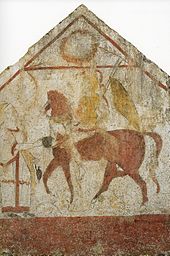Grave of the returning knight
The grave of the returning knight is a man's grave from around 370 BC. BC, which was found in a necropolis near Paestum . His remains are kept under inventory numbers 5021 to 5024 in the National Archaeological Museum there.
Grave slabs
The four walls of the box grave painted on the inside have been preserved. They formed a burial chamber in the form of a house with a gable roof. The pentagonal plate on the east side, where the head of the buried person once lay, shows the motif of the returning knight, after whom the grave was named. The man is sitting barefoot, but in a helmet and armor, on a horse with a lantern, striding to the left, in reddish-brown paint . Two lances, on which apparently a trophy from a fight, a shield, hangs, lie over his shoulder. The knight is welcomed by a woman in a long, red-braided robe, who holds out a black drinking vessel with her right hand, while another vessel hangs down from her left hand. This second vessel is very small compared to the first and therefore probably represents the jug from which the donation was poured onto the grave, so that in this scene the return and departure of the deceased are shown united.
While the female figure with her black shoes is standing directly on the broad, red-brown field that delimits the painting at the bottom - as on the three other panels too - the horse strides across another surface, indicated by pale wavy lines and plant structures. The unclothed parts of the body of the two people are represented by dark outlines and have the same white color as the background of the fresco.
The heads of the rider and the horse as well as the lance tips also protrude into the gable of the plate, which is divided approximately halfway up by a horizontal red line, above which there is still a wreath. The two sides of the pediment are also framed by red lines.
Elements of the funeral games can be seen on the longitudinal panels. The southern panel shows on the left a boxing match being watched by a flute player, and on the right, separated from the left by a pillar indicated almost exactly in the middle, two naked warriors protected with helmets and shields are and carry out gun fights. To their right, a referee in a long robe, who is just raising his hand, is watching the fight scene. In addition to the column, representations of trees are used as structuring elements.
While the flute player and the referee are only drawn with thin, dark outlines like the figures on the east plate, the contours of the fighters are each reinforced by a broad brown brushstroke. At the top, the painting is completed by two red lines between which a second motif can be seen. A scene from a chariot race can be seen on the northern plate; two couples pursue each other. The driver in front is apparently just behind the pillar, which can also be found here and shows a broad brown contour line on one side, into a curve and has pulled the reins of his horses, the one behind drives his animals to run with loose reins. A wreath or garland of leafy twigs hangs down over the horse's back, the upper end is designed the same as on the opposite plate. Here, too, gaps in the painting are filled with vegetable elements. The groups of people on the longitudinal plates can be found in a similar way, for example in the grave of pomegranates .
The painting on the narrow panel on the west side of the grave is only moderately well preserved. According to Bernard Andreae , it shows the person buried hunting deer. Two pomegranates can be seen in the gable flanking a wreath.
exhibition
The grave of the returning knight was the first of the Paestum graves shown in 2007 as part of an exhibition in Hamburg and in the Martin-Gropius-Bau in Berlin to be put back together in the form of a sarcophagus. The grave slabs can only be shown individually in the museum in Paestum because their weight does not allow them to be presented in the original arrangement.
literature
- Ortrud Westheider, Michael Philipp (Ed.): Painting for eternity. The graves of Paestum , Hamburg / Munich 2007, ISBN 978-3-7774-3745-3 , pp. 52–59.
Individual evidence
- ↑ Ortrud Westheider and Michael Philipp (eds.): Painting for Eternity. The graves of Paestum , Hamburg / Munich 2007, ISBN 978-3-7774-3745-3 , p. 52
Coordinates: 40 ° 25 ′ 24.5 ″ N , 15 ° 0 ′ 26.7 ″ E


